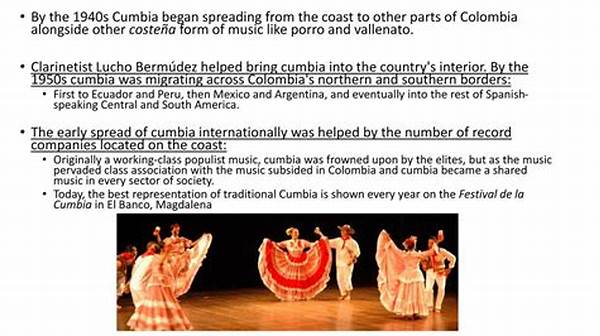Cumbia, the vibrant and eclectic dance rhythm, has been revolutionizing the music world and breaking barriers across Latin America and beyond. Imagine the pure, unadulterated beats of cumbia wafting through the air, worth every sway and twirl it demands. It’s not just music; it’s a movement that draws people in, touching souls and evoking indescribable joy. This captivating fusion of African, Indigenous, and Spanish sounds has evolved, transcending boundaries with its infectious beat and captivating melodies.
Read Now : English Hits Trending In Indonesia
Cumbia’s Global Journey
The evolution of cumbia across borders is a testament to music’s universal language. Cumbia’s journey began in Colombia’s Caribbean coastal region, where African slaves introduced percussion-rich sounds. As these rhythms started to mingle with Indigenous flutes and Spanish lyrics, cumbia’s distinctive sound was born. But this was just the beginning. As cumbia found itself voyaging across the Americas, it adopted local instrumentation and flavors, giving birth to new styles while retaining its original allure. From Mexico’s brass-infused cumbia sonidera to Argentina’s electronic twists, cumbia grooves have become the heartbeat of parties worldwide, proving that borders can’t confine the spirit of dance and music.
The Dance Floor Revolution
Yo, you ever hit a party and they drop some cumbia? That’s the evolution of cumbia across borders making its mark on the scene. Whether you’re in the vibrant streets of Mexico or chilling in Buenos Aires, cumbia becomes an instant crowd magnet. People, no matter where they’re from, just can’t resist the urge to move. It’s like that secret sauce that spices up any gathering, bringing folks together in a shared rhythm. The dance floor lights up, the vibe’s electric, and suddenly, you’re in a space where cultures mingle and boundaries blur. The evolution of cumbia across borders is what makes it a dance floor revolution, man.
From Local to Global Phenomenon
Once a regional treasure of Colombia, cumbia has catapulted into a global phenomenon through the evolution of cumbia across borders. It’s like a passport-free journey, man. Different countries have put their spin on it, making it their own yet preserving those original beats that started it all. Think of cumbia in Mexico—brass horns blaring, everyone getting down to that sonidera sound. Or take Argentina, where cumbia villera infuses the streets with a raw, urban edge. Then you got Peru, putting psych-rock twists on the classic melody. Through the evolution of cumbia across borders, these diverse takes preserve the beat’s core, a potent reminder of where it all began while simultaneously blazing a trail into new musical territories.
The Soundtrack of Unity
Ain’t nothing like cumbia to bring people together, and that’s no cap. The evolution of cumbia across borders is all about unity. What started in Colombia has grown into this massive cultural handshake, a global nod that we all speak the same language when it comes to music and movement. Cumbia’s not confined to one space; it’s like the world’s party invite, spreading joy and connection. From backyard barbecues to international music festivals, when cumbia’s on, the message is clear: walls come down, and the dance floor becomes everyone’s common ground.
Cumbia’s Cultural Exchange
Stepping onto the cumbia scene is like entering a cultural exchange where the evolution of cumbia across borders takes center stage. It’s like, cumbia doesn’t just jam with its traditional elements. Nah, it picks up the vibes from wherever it lands. You got the tango influences in Argentina, the Andean rhythms in Peru, and the salsa flair in parts of the Caribbean—all these components blend seamlessly into cumbia’s fabric. Each tweak and turn in this dance rhythm are like conversations between cultures, showing off the power of collaboration and creativity. And let’s be real, it’s this exchange that keeps cumbia alive and thriving on the global stage.
Read Now : J-pop Streaming Services Growth
A Tapestry of Influence
The beauty of cumbia lies in its evolution across borders, morphing into new forms while staying true to its roots. This dynamic sound that’s spread globally through cultural exchange is a tapestry woven with African, Indigenous, and Spanish influences. From its Colombian origins to its widespread impact, cumbia reflects a mixture of diverse elements harmonizing together. Over time, as countries like Chile, Uruguay, and beyond have embraced it, they have layered cumbia with their unique cultural nuances. The rhythm has seen countless transformations, yet the underlying beats remain a shared language that resonates with many.
Conclusion: Cumbia Unites Us All
In conclusion, the evolution of cumbia across borders is nothing short of inspiring. It’s not just about the music; it’s about the stories and connections that blend through its beats. Cumbia’s evolution exemplifies how it transcends language and unites diverse cultures, people, and traditions. It’s a testament to the power of music, showing that even across great distances and differences, we’re all dancing to the same tune. Whether you’re a lifelong cumbia enthusiast or discovering its magic for the first time, there’s no denying its energizing pull. So, let’s keep the vibe alive and celebrate cumbia’s ongoing journey—a testament to its lasting legacy and influence around the world.
